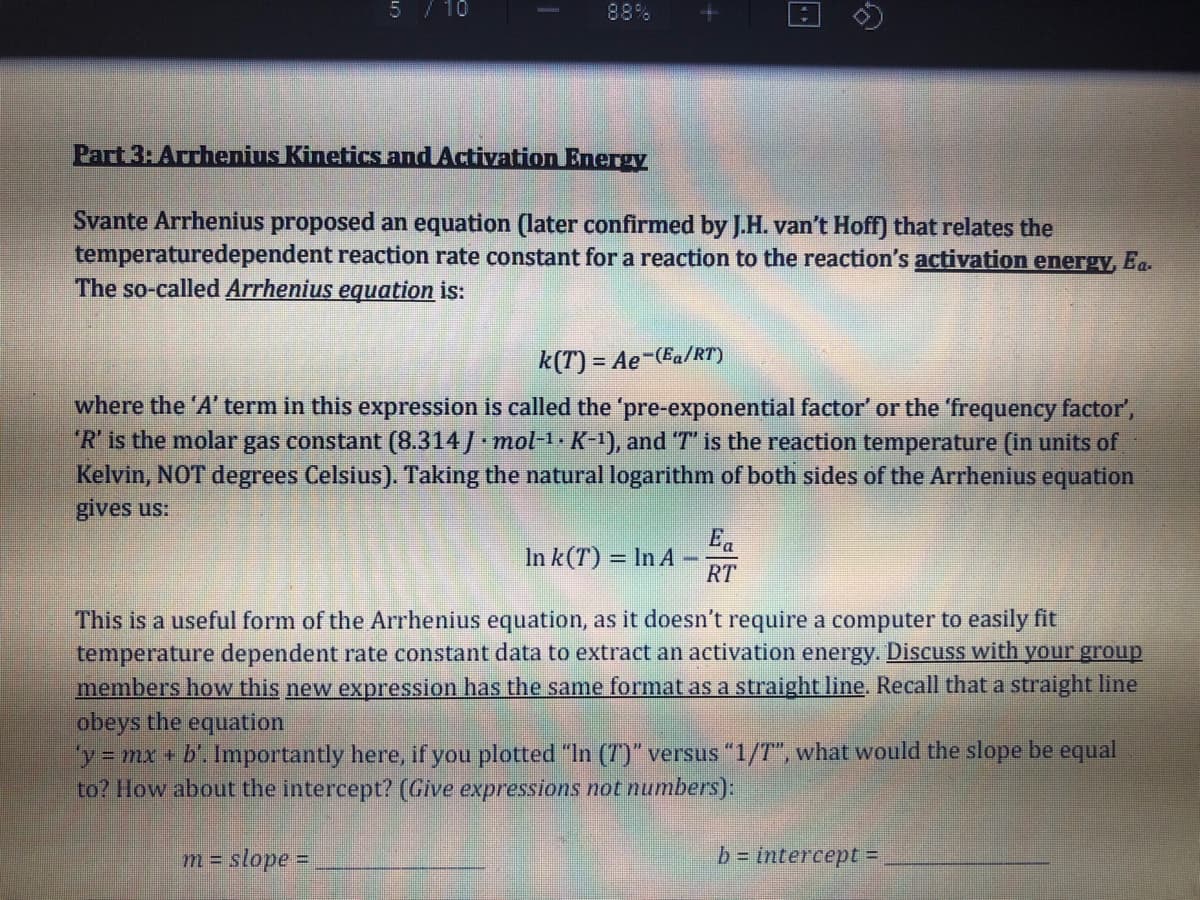Part 3: Arrhenius Kinetics and Activation Energy Svante Arrhenius proposed an equation (later confirmed by J.H. van't Hoff) that temperaturedependent reaction rate constant for a reaction to the reaction's ac The so-called Arrhenius equation is: k(T) = Ae-(Ea/RT) %3D where the 'A' term in this expression is called the 'pre-exponential factor' or the R' is the molar gas constant (8.314/ mol-1. K-1), and T" is the reaction temper Kelvin, NOT degrees Celsius). Taking the natural logarithm of both sides of the A gives us: Ea In k(T) = In A RT %3D This is a useful form of the Arrhenius equation, as it doesn't require a computer temperature dependent rate constant data to extract an activation energy. Discu members how this new expression has the same format as a straight line, Recall obeys the equation y = mx + b'. Importantly here, if you plotted "In (7)" versus "1/T", what would th to? How about the intercept? (Give expressions not numbers): %3D m= slope= b intercept = %3D %3D
Part 3: Arrhenius Kinetics and Activation Energy Svante Arrhenius proposed an equation (later confirmed by J.H. van't Hoff) that temperaturedependent reaction rate constant for a reaction to the reaction's ac The so-called Arrhenius equation is: k(T) = Ae-(Ea/RT) %3D where the 'A' term in this expression is called the 'pre-exponential factor' or the R' is the molar gas constant (8.314/ mol-1. K-1), and T" is the reaction temper Kelvin, NOT degrees Celsius). Taking the natural logarithm of both sides of the A gives us: Ea In k(T) = In A RT %3D This is a useful form of the Arrhenius equation, as it doesn't require a computer temperature dependent rate constant data to extract an activation energy. Discu members how this new expression has the same format as a straight line, Recall obeys the equation y = mx + b'. Importantly here, if you plotted "In (7)" versus "1/T", what would th to? How about the intercept? (Give expressions not numbers): %3D m= slope= b intercept = %3D %3D
Chemistry & Chemical Reactivity
9th Edition
ISBN:9781133949640
Author:John C. Kotz, Paul M. Treichel, John Townsend, David Treichel
Publisher:John C. Kotz, Paul M. Treichel, John Townsend, David Treichel
Chapter14: Chemical Kinetics: The Rates Of Chemical Reactions
Section: Chapter Questions
Problem 86IL: The acid-catalyzed iodination of acetone CH3COCH3(aq) + I2(aq) CH3COCH2I(aq) + HI(aq) is a common...
Related questions
Question

Transcribed Image Text:5/10
88%
Part 3: Arrhenius KineticS and Activation Energy
Svante Arrhenius proposed an equation (later confirmed by J.H. van't Hoff) that relates the
temperaturedependent reaction rate constant for a reaction to the reaction's activation energy, Ea.
The so-called Arrhenius equation is:
k(T) = Ae-(Ea/RT)
%3D
where the 'A' term in this expression is called the 'pre-exponential factor' or the 'frequency factor',
"R' is the molar gas constant (8.314 J mol-1 K-1), and T" is the reaction temperature (in units of
Kelvin, NOT degrees Celsius). Taking the natural logarithm of both sides of the Arrhenius equation
gives us:
In k(T) = In A
Ea
RT
This is a useful form of the Arrhenius equation, as it doesn't require a computer to easily fit
temperature dependent rate constant data to extract an activation energy. Discuss with your group
members how this new expression has the same format as a straight line, Recall that a straight line
obeys the equation
y= mx + b'. Importantly here, if you plotted "In (7)" versus "1/T", what would the slope be equal
to? How about the intercept? (Give expressions not numbers):
m = slope =
b = intercept =
Expert Solution
This question has been solved!
Explore an expertly crafted, step-by-step solution for a thorough understanding of key concepts.
Step by step
Solved in 2 steps with 1 images

Knowledge Booster
Learn more about
Need a deep-dive on the concept behind this application? Look no further. Learn more about this topic, chemistry and related others by exploring similar questions and additional content below.Recommended textbooks for you

Chemistry & Chemical Reactivity
Chemistry
ISBN:
9781133949640
Author:
John C. Kotz, Paul M. Treichel, John Townsend, David Treichel
Publisher:
Cengage Learning

Chemistry & Chemical Reactivity
Chemistry
ISBN:
9781337399074
Author:
John C. Kotz, Paul M. Treichel, John Townsend, David Treichel
Publisher:
Cengage Learning

Chemistry for Engineering Students
Chemistry
ISBN:
9781337398909
Author:
Lawrence S. Brown, Tom Holme
Publisher:
Cengage Learning

Chemistry & Chemical Reactivity
Chemistry
ISBN:
9781133949640
Author:
John C. Kotz, Paul M. Treichel, John Townsend, David Treichel
Publisher:
Cengage Learning

Chemistry & Chemical Reactivity
Chemistry
ISBN:
9781337399074
Author:
John C. Kotz, Paul M. Treichel, John Townsend, David Treichel
Publisher:
Cengage Learning

Chemistry for Engineering Students
Chemistry
ISBN:
9781337398909
Author:
Lawrence S. Brown, Tom Holme
Publisher:
Cengage Learning

Chemistry: Principles and Reactions
Chemistry
ISBN:
9781305079373
Author:
William L. Masterton, Cecile N. Hurley
Publisher:
Cengage Learning

Chemistry by OpenStax (2015-05-04)
Chemistry
ISBN:
9781938168390
Author:
Klaus Theopold, Richard H Langley, Paul Flowers, William R. Robinson, Mark Blaser
Publisher:
OpenStax

Chemistry
Chemistry
ISBN:
9781305957404
Author:
Steven S. Zumdahl, Susan A. Zumdahl, Donald J. DeCoste
Publisher:
Cengage Learning